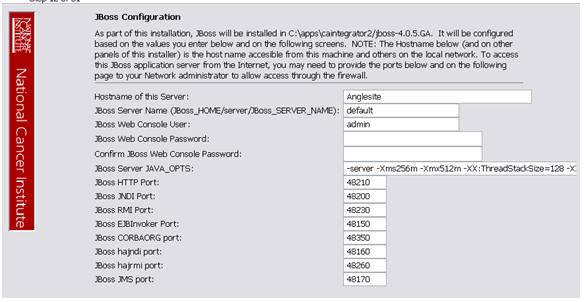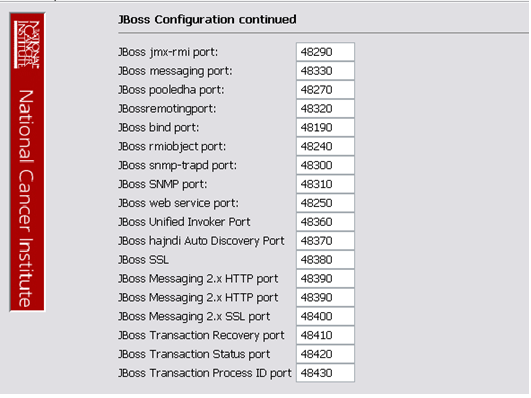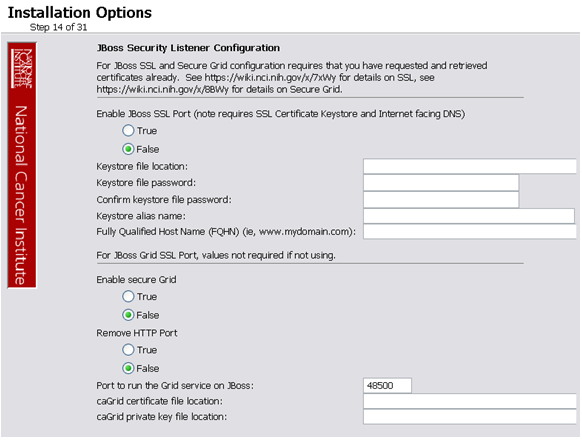 |
Page History
...
Many of the servers and services that make up caIntegrator are automatically installed as part of this caIntegrator v.1.3 4 installation. However, prior to the installation, you must download and install the following required tools and recommended versions in the order they are listed in the table. The software name, version, description, and URL hyperlinks (for download) are indicated in the table. Complete the directions for installing each, as directed on the corresponding website.
...
- From the command line, enter:
echo %JAVA_HOME%*
echo %ANT_HOME%*
Both of these commands should return the location where you installed these tools. - To verify your Java SDK installation, enter
java --versionfrom a command prompt. You should seejava version "1.6.0_18". - To verify your Ant installation, enter
ant --versionInfo title Other environment variables Environment variables for caIntegrator and, optionally, UPT are modified and set in those sections of this document: #Installing a New caIntegrator v.1.34||\ and #Downloading and Installing UPT (Optional)||\.
MySQL Installation and Configuration
...
| Info | ||
|---|---|---|
| ||
UPT 4.2 is backwards compatible to previous versions of CSM. When you provision the application in UPT 4.2, you will be asked to specify the CSM version caIntegrator is using. You should enter version |
Installing caIntegrator v.1.
...
4 Application and Services
To newly install the caIntegrator v.1.3 4 application and services, follow the steps in these sections:
- #Downloading caIntegrator v.1.3 4 Files||\
- #Installing a New caIntegrator v.1.34||\
- #Configuring JBoss||\
- #Post-Installation Tasks||\
| Note | ||
|---|---|---|
| ||
There must already be a pre-existing MySQL DB and connection username/password for caIntegrator to install into; caIntegrator does not create its own DB. |
Downloading caIntegrator v.1.
...
4 Files
To download the caIntegrator v.1.3 4 files, follow this step:
The various installation files for caIntegrator v.1.3 4 are between 150-250MB in size. All of the files can be downloaded from the caIntegrator distribution folder.
- For a new command-line installer, download the
caIntegrator_install_1_34.zipfile (around 175MB). - For a command-line upgrade installer, download the
caIntegrator_upgrade_1_34.zipfile (about 175 MB). - For a GUI installer that you can use to do a fresh caIntegrator installation, download the
caIntegrator_gui_distribution_1_34.jarfile (about 207 MB).
Remember the download location, as you will be using this file to run the installation in the steps that follow.
| Tip | ||
|---|---|---|
| ||
These server components are installed and configured as part of the caIntegrator v.1.3 4 installation. You do not need to do anything further to download or install these components.
|
Installing a New caIntegrator v.1.
...
4
You can perform a new installation of caIntegrator v.1.3 4 using either of these two methods:
- A GUI Installation wizard. Instructions for this method start in the following section.
- A command-line installation. For instructions, see #Command-Line Method of Installation||\.
GUI Installer Method of Installation
...
- Open a command prompt in the directory where you downloaded the
caIntegrator_gui_distribution_1_34.jar. Enter this command to invoke the GUI installer:java --jar caIntegrator_gui_distribution_1_34.jar. - The Installation Wizard opens to facilitate the installation process. Click Next to proceed through the pages of the wizard, beginning with progressing past the Welcome page.
- Review the release notes.
- You must accept the license agreement.
- Select the Install installation type. For a new installation, select Install.
- Select Browse to navigate to the directory where you would like to install caIntegrator. The directory then displays in the text box. If the folder does not yet exist, click OK in the dialog box to indicate that you want the folder to be created.
- Select the type of installation you would like to do. You can install everything, or just specific components (JBoss or Database only). The remaining sections in this guide assumes you chose to install everything.
- Continue walking through the pages of the installer. Configure the caIntegrator JBoss server on the next two pages of the installation wizard. The screen shots show example values. The port values which are specified are the defaults and can be used unless you want to reconfigure the values because of values already in use.
- JBoss Installation Options
- JBoss SSL requires that you have requested and retrieved certificates already. If this does not apply to your installation, leave the values as false and continue.
- If your JBoss is externally accessible then fill out the JBoss External Hostname Configuration page. Otherwise, leave it blank and continue.
- Specify the authentication type that caIntegrator should use. Database is the most likely choice if you aren't sure what to select here.
- If you selected LDAP in the previous step (authentication type), enter the appropriate configuration information for LDAP: the LDAP URL and the LDAP Search Back DN.
- If the authentication type is database, specify the following data base configuration information:
- The Database Host Name
- The Database Port Example: 3306
- Database name of the pre-existing database where the caIntegrator schema will be installed
- The pre-existing Database Application User to be used by caIntegrator to connect to its database.
Error messages inform you if the following occurs:- If the specified database host cannot be reached, or the field is blank.
- If the specified database does not already exist, or the caIntegrator DB user's credentials are wrong.
- If the specified database host cannot be reached, or the field is blank.
- Specify SMTP mail server connection information so that caIntegrator can send emails from users with new account requests. You must provide the following
- Mail Server Host Example:
localhost - Mail Server Port Number Example:
25 - Mail Server Authentication: default is false.
- Mail Server starttls: default is false.
- Mail Server Host Example:
- If jar signing is necessary for the installation, then enable it on the Jar Signing Configuration page. This step is optional and can be skipped.
- Review the summary of the information you entered.
- Review the selected installation type and the installation destination.
After you click Next from reviewing the installation destination, the installer runs. The installation wizard displays the installation progress and completion. - When you are informed that the process is finished, click Done in the lower right corner of the wizard to close the installer.
- To verify caIntegrator installation:
- Open your web browser to installed instance. The URL follows this format: http://<jboss.server.hostname>:<jboss.server.port>/caintegrator/workspace.action.
- Enter ncimanager as the user and changeme as the password. Refer to the
<user home>/.installer-caintegrator/caintegrator_installer/install.propertiesfile for the correct values.
- After successfully installing caIntegrator, make a backup of the
<user home>/.installer-caintegrator/caintegrator_installer/install.propertiesfile in a different directory for future reference.
...
- From the directory where you downloaded the
caIntegrator_distribution_1_3.zipdescribed in Downloading caIntegrator v.1.3 4 files\, unzip the Files, using one of these two methods:- Open a command prompt and use it to extract this file to a temporary location. For example, you may enter a command such as
unzip -q caIntegrator_distribution_1_3.zip. You must have a ZIP tool installed. This location will be referred to as the<installer_directory>henceforth. - Use WinZip or a similar utility to unzip the files to a temporary location. This location will be referred to as the
<installer_directory>henceforth.
Example:<installer directory>=C:\caIntegrator_installerInfo title About setting property values Setting the property values is an important step in the installation process. Before you complete steps 2 & 3, review #Working with Properties Files||\.
- Open a command prompt and use it to extract this file to a temporary location. For example, you may enter a command such as
- Open the
<installer_directory>/install.propertiesfile, modify the values for your environment and save the file. For the latest details about configuring the properties for your environment, refer to the BDA Properties wiki page. - Record the property values you have set.
Info title Other default values You should not need to modify the other default values as we have chosen unique ports to reduce the risk of other applications using the same values. However, be sure to verify that the ports in this file are not being used by other applications.
- From the command line, navigate to
<installer_directory>/(Example:cd C:\caIntegrator_2_0_installer), and typeant. This initiates the installation process. The anticipated duration is anywhere from 1-15 minutes, depending on your system's speed, power and memory.
The installer installs the caIntegrator schema in the specified pre-existing database on your MySQL server, and installs, configures, and starts the JBoss server for the caIntegrator application. - To verify caIntegrator installation, open your web browser to the installed instance. The URL follows this format: http://<jboss.server.hostname>:<jboss.server.port>/caintegrator/workspace.action.
Refer to the<installer_directory>/install.propertiesfile for the correct values. Enter manager as the user and manager as the password. - After successfully installing caIntegrator, make a backup of the
<installer_directory>/install.propertiesfile in a different directory for future reference.
Upgrading caIntegrator 1.
...
3 to 1.
...
4
This section describes how to upgrade your product from caIntegrator 1.2 3 to caIntegrator 1.34. The instructions in this section apply only if you have already installed a caIntegrator version 1.23.
You can perform an upgrade installation of caIntegrator v.1.3 using either of these two methods:
- A GUI Installation wizard. Instructions for this method are found in #Upgrade Using the GUI Installer||\.
- A command-line installation. Instructions for this method are found in #Upgrade Using Command-Line Installer||\.
| Note | ||
|---|---|---|
| ||
|
If you are performing a new installation, go directly to #Installing caIntegrator v.1.3 4 Application and Services||\.
caIntegrator 1.
...
3 Users Upgrading to caIntegrator 1.
...
4
The directions in this section presume that you have a valid and functioning caIntegrator 1.23. It also assumes that Java SDK, Apache Ant and MySQL have all been successfully uploaded and installed, as described on pages #Required Software--Not Included in caIntegrator||\.
Overview of Properties Files
When you installed the previous version of caIntegrator 1.23, you configured the install.properties file. To complete the upgrade to caIntegrator 1.34, you must use some of the values from the original install.properties to configure values in the upgrade installer wizard GUI, or the upgrade.properties file if you are doing a command-line method of upgrade.
See steps 3 & 4 in #Upgrade Using Command Line Installer||\ for more information.
Upgrade Using the GUI Installer
...
To perform an upgrade to caIntegrator 1.3 4 using the GUI Installation Wizard, follow these steps:
- Because of the application name change in v.1.34, in the JBOSS home directory, locate the war file containing the previous release of caIntegrator2 and delete it. For example, find this file:
JBOSS_HOME/server/default/deploy/caintegrator2.warand delete the file namedcaintegrator2.war.Warning title Watch .war file name In this same directory, there may be a different file named
caintegrator.war(without the number 2 in the name) which you should not delete. - Open a command prompt in the directory where you downloaded the
caIntegrator_gui_distribution_1_34.jarand invoke the GUI installer using this:java --jar caIntegrator_gui_distribution_1_34.jar. - The Installation Wizard opens to facilitate the installation process. Click Next to proceed through the pages of the wizard, beginning with progressing past the Welcome page.
- Review the release notes.
- You must accept the license agreement to continue.
- Select the Upgrade installation type.
- Configure the JBoss Server-related upgrade settings.
If the path pointing to the caIntegrator installation to be upgraded is incorrect, an error message appears. - Specify the authentication type that caIntegrator is using. If you choose LDAP, configure the LDAP information: the LDAP Host Name, the LDAP Search Base, and the LDAP Search Prefix. An example of the Host Name is
ldaps://myldaphost.mydomain.com:636. - Review the summary of gathered information.
- Click Next to proceed through the next two pages. Review the selected upgrade installation type and the upgrade destination.
- After you click Next from reviewing the installation destination, the installer runs. The installation wizard displays the installation progress and completion.
- When you are informed that the process is finished, click Done in the lower right corner to close the installation wizard.
- To verify the caIntegrator installation, open your web browser to the installed instance. The URL follows this format: http://<jboss.server.hostname>:<jboss.server.port>/caintegrator. Example: http://hostname:47210/caintegrator and enter ncimanager as the user and changeme as the password. Refer to the original
install.propertiesfor the correctjboss.server.hostnameandjboss.server.portvalues.
...
- Because of the application name change in v.1.3, in the JBOSS home directory, locate the war file containing the previous release of caIntegrator2 and delete it. For example, find this file:
JBOSS_HOME/server/default/deploy/caintegrator2.warand delete the file namedcaintegrator2.war.Warning title Watch .war file name In this same directory, there may be a different file named
caintegrator.war(without the number 2 in the name) which you should not delete. - From the directory where you downloaded the upgrade zip file, extract the files, using one of these two methods:
- Open a command prompt and use it to extract this file to a temporary location. For example, you may enter a command such as
unzip -q caIntegrator_upgrade_1_3.zip. You must have a ZIP tool installed.Info title Directory for unzipped files It is recommended that you use a new directory for the unzipped files, rather than the one you used to unzip the installer for the previous version(s) of caIntegrator. This location will be referred to as the
<upgrade_installer_directory>henceforth. - Use WinZip or a similar utility to unzip the files to a temporary location. This location will be referred to as the
<upgrade_installer directory>henceforth
Example:<upgrade_installer directory> = C:\caintegrator2_1_2_upgrade_installer
- Open a command prompt and use it to extract this file to a temporary location. For example, you may enter a command such as
- Edit the default properties in the
<upgrade_installer_directory>/upgrade.propertiesfile. Before doing so, review #Working with Properties Files||\.
To do so, open both properties files, the one you configured originally when you installed the previous version of caIntegrator. (<install. properties file>)and the<upgrade_installer_directory>/upgrade.propertiesfile.
For the latest details about configuring the properties for your updated environment, refer to the BDA Properties page.Info title Note The
upgrade.propertiesfile does not have as many attributes, so you will not need to transfer all values you set in the previous installation file. - Record these property values.
Info title Modifying property values You shouldn't need to modify the other default values as we have chosen unique ports to reduce the risk of other applications using the same values. However, be sure to check the
*.propertiesfile to verify that the ports in this file are not being used by other applications. - From the command line, navigate to
<upgrade_installer_directory>/(Example:cd C:\caIntegrator_upgrade_installer), and type ant. This initiates the upgrade process. The anticipated duration is anywhere 1-15 minutes depending on your system's speed, power and memory.
The installer upgrades your existing caIntegrator database on your MySQL server, and starts your existing JBoss server. - When the installer detects that a database exists, it warns you to back it up, which you were instructed to do earlier in this process. Press Y to proceed.
- To verify caIntegrator installation, open your web browser to the installed instance. The URL follows this format: http://<jboss.server.hostname>:<jboss.server.port>/caintegrator /workspace.action. Example: http://hostname:47210/caintegrator/workspace.action and enter ncimanager as the user and changeme as the password. Refer to the original install.properties for the correct
jboss.server.hostnameandjboss.server.portvalues.
...


